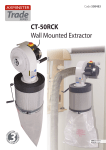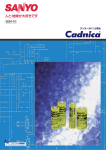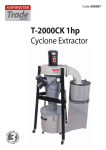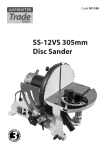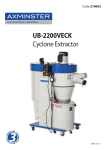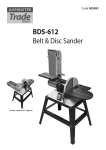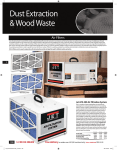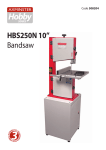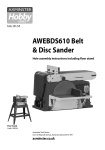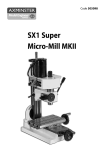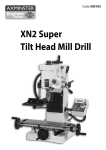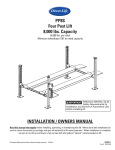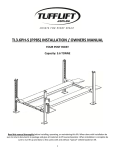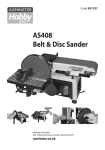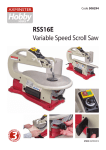Download Axminster T-2000CK Operating instructions
Transcript
Code 508338 T-2000CK-200H 2hp Cyclone Extractor AT&M: 26/03/2015 REF: 508500 Index of Contents Index of Contents Declaration of Conformity What’s Included General Safety Instructions for 230V Machines Specification Assembly Machine Footprint Illustration and Parts Description Operating Instructions Ducting System Maintenance Weekly LEV System Maintenance Log LEV Testing Extraction Accessories Exploded Diagram/Parts List Wiring Diagram Notes 02 03 04-05-06 07-08 08 08-09-10-11-12-13-14-15-16 17 18-19-20-21 22-23 23 24 25-26 27 27 28-29 30 31 Declaration of Conformity Copied from CE Certificate The undersigned, George N. Sifonios Authorised by META INTERNATIONAL CO., LTD NO. 38-46, Ya Tan Rd., Ta Ya Hsiang. Taichung Hsien, Taiwan, R.O.C., Manufactured by META INTERNATIONAL CO., LTD is in compliance with the standards determined in the following Council Directive. Applicable Directive: 2006/42/EC Applicable Standards: EN ISO 12100-1:2003+A1:2009, EN ISO 12100-2:2003+A1:2009 Model Number T-2000CK (Dust Collector) Warning Fully read manual and safety instructions before use Ear protection should be worn The symbols below advise that you follow the correct safety procedures when using this machine. Eye protection should be worn 2 Dust mask should be worn HAZARD Motor gets hot What’s Included Quantity Item Part 1 No T-2000CK-200H Cyclone Extractor 1 No 4 No 4 No 2 No 2 No 4 No 1 No 1 No 1 No 1 No 1 No 1 No 1 No 1 No 1 No 1 No 1 No 1 No 2 No 1 No Motor Assembly Upper Leg Square Tubes Lower Leg Square Tubes Long Cross Support Brackets Short Cross Support Brackets Leg Bracket Connectors Extractor Drum Flexible Hose Bin Bin Cover Filter Lid (Air Filter Cartridge) Extraction Funnel Inlet Manifold Air Filter Cartridge Shaker Paddle Operating Handle Operating Handle Extension Bar Manometer Manometer Hose Dust Bags Bin Handle Model Number 1 2 3 4 5 6 7 8 9 10 11 12 13 14 15 16 17 18 19 20 4 No 4 No 1 No 2 No 3 No 1 No 1 No Castor Wheels Bin Castor Wheels Dust Bag Securing Belt Large and Small Clips Bin Lever Clamps with Phillips Screws and Nuts 6-7 and 10-12mm Spanners 4-5mm Hex Keys 21 22 23 24 25 26 27 Cyclone Extractor Fixings 6 No 2 No 1 No 27 No 48 No 2 No 6 No 8 No 1/4" Nuts 1/4" Domed Head Nuts M6 x 12mm Bolts No: 10 ANC Cap head Screws 5/16" Button Head Bolts 1/4" Button Head Phillips Screws 1/4" Hex Bolts 5/16" Hex Bolts Please read the Instruction Manual prior to using your new machine. As well as the operating procedures for your new machine, there are numerous hints and tips to help you to use the machine safely and to maintain its efficiency and prolong its life. There is also a detailed description of the parts of your Extractor, which will enable you to become familiar with terminology we will use in this manual. Keep this Instruction Manual readily accessible for any others who may also be required to use the machine. 2 1 3 3 a b c d e f g h What’s Included 4 5 6 7 8 9 10 4 What’s Included 11 12 13 14 15 16 19 18 20 17 5 What’s Included 23 21 22 24 27 a 25 26 b c d e 6 f g h General Safety Instructions for 230V Machines Good Working Practices/Safety The following suggestions will enable you to observe good working practices, keep yourself and fellow workers safe and maintain your tools and equipment in good working order. WARNING!! KEEP TOOLS AND EQUIPMENT OUT OF THE REACH OF YOUNG CHILDREN Mains Powered Tools and Machines Primary Precautions These machines are supplied with a moulded 16 Amp plug and 3 core power cable. Before using the machine, inspect the cable and the plug to make sure that neither are damaged. If any damage is visible, have the damaged item inspected/repaired by a suitably qualified person. If it is necessary to replace the plug, it is preferable to use an ‘unbreakable’ type that will most resist damage. Only use a 16 Amp plug, and make sure the cable clamp is tightened securely. Fuse as required. If extension leads are to be used, carry out the same safety checks on them, and ensure that they are correctly rated to safely supply the current that is required for your machine. Remember, most machines or tools have handles or holding positions, the power cable is not one of them. Workplace/Environment The machine is not designed for use outside. Keep the machine clean; it will enable you to more easily see any damage that may have occurred. Clean the machine with a damp soapy cloth if needs be, do not use any solvents or cleaners, as these may cause damage to any plastic parts or to the electrical components. It is good practice to leave the machine unplugged until work is about to commence, also make sure to unplug the machine when it is not in use, or unattended. To avoid inadvertent ‘start up’, if your machine is not fitted with a KEEP THE WORK AREA AS UNCLUTTERED AS IS PRACTICAL, THIS INCLUDES PERSONNEL AS WELL AS MATERIAL. UNDER NO CIRCUMSTANCES SHOULD CHILDREN BE ALLOWED IN WORK AREAS. NVR system, ensure the switch is always returned to the OFF position. Once you are ready to commence work, remove any tools, objects or items that could inadvertently get ‘sucked up’ by the machine and place safely out of the way. Re-connect the machine, ensuring the power cable is not ‘snagged’ or routed where it could be tripped over as you move about the workshop; it is not too close to an unguarded heat source, or is laid over or around a sharp edge. If the work you are carrying out is liable to generate flying grit, dust or chips, wear the appropriate safety clothing, goggles, gloves, masks etc. If the work operation appears to be excessively noisy, wear ear-defenders. If you wear your hair in a long style, wearing a cap, safety helmet, hairnet, even a sweatband, will minimise the possibility of your hair being caught up in the rotating parts of the machine. Likewise, consideration should be given to the removal of rings and wristwatches if these are liable to be a ‘snag’ hazard. Consideration should also be given to non-slip footwear, etc. Do not use this machine if you are tired, your attention is wandering or you are being subjected to distraction. Do not use this machine within the designated safety areas of flammable liquid stores or in areas where there may be volatile gases. There are very expensive, very specialised machines for working in these areas. Above all, OBSERVE…. make sure you know what is happening around you, and USE YOUR COMMON SENSE. Specific Safety for Dust Extractors Do not use this machine as a vacuum cleaner, try to keep the waste medium to wood by products. Do not uplift workshop floor debris (stones, nails, screws, paper etc., etc). Be aware that wood dust is an explosive medium. Do not allow any ‘naked light’ source to occur anywhere near the machine. This includes cigarettes, matches, etc, and do not place the machine near any unprotected light bulbs, that could possibly get broken. The suction force is generated by a high speed fan unit. This has the potential to amputate fingers, grab loose clothing (ties etc.,) and ‘bat’ large chips etc, at high speeds. Keep all guarding in place, and if access to the fan becomes necessary (due to blockage etc.), disconnect the machine from the mains supply and ensure the fan has come to a complete stop before putting your hands anywhere near to it. If you are not using ‘clear’ extraction hose, periodically remove the hose to check that the inlet to the machine is not getting restricted. (The safety guard grill of the inlet duct can be particularly irksome in this way, as long strand shavings etc., can wrap around the grill fret.) Keep the particle filter clean. The machine relies on its ability to ‘blow’ air through the filter, to generate good suction. Continues Over.... 7 General Safety Instructions for 230V Machines If the particle filter starts to clog, this reduces the air flow and hence the machine becomes less efficient. If possible, try to connect everything together electrically, to eliminate static shocks. The particle filter can be cleaned, by using an ‘M’ class vacuum cleaner, clean the inside of the filter. (Use the integral metal coil in flexible plastic hosing to connect units together). Be aware that in dry air periods or areas, the movement of the air through the machine can generate static electric fields. This is not normally a problem as the machine is bonded together via its construction and the whole is earthed back through the electrical supply. Problems can occur with isolated items, such as stands or hosing that are insulated from the ground (standing on rubber feet), suspended in the air etc. Try to route the power cable and the hosing away from busy walkways. Do not allow the inlet to become ‘dead ended’, or block or restrict the outlet, this puts undue strain on the motor and can lead to overheating. NOTE: DO NOT FIT PLASTIC WASTE BAGS TO THIS MACHINE! Specification Model Code Rating Power Air Flow Noise Level Filter Area Filtration Particle Size Hose Diameter Overall L x W x H Weight T-2000CK-200H 508338 Trade 1.5kW (230V, 1ph) 2,300m³/hr 84dB @ 3m 7.4m² 1 micron 1 micron 180mm x 1, 100mm x 2 1,250 x 1,000 x 1,800mm 83kg Assembly Please read through the section entitled Parts Identification and Description, this will enable you to more readily identify those parts of the cyclone extractor. Please note: some of this assembly procedure is best accomplished by two persons. Although the tasks are not impossible, some of the items are heavy and awkward, and a mishandling error could cause injury. Please think about what you are doing, your capabilities and your personal safety. We have added the ‘two person symbol’ to any operation that we recommend should be a two person task. Unpack all the boxes and check all the components listed in the “What’s Included” section. If any parts or components are missing, please contact our Customer Services Department using the procedures and telephone numbers listed in our catalogue. Please note: on occasions the packing list is not strictly adhered to. Please check all the boxes, packets etc. to make sure that all the parts have been accounted for. PLEASE RECYCLE ANY UNWANTED PACKAGING RESPONSIBLY! 8 Assembly Having unpacked the boxes, put all components where they are readily to hand. Locate the motor assembly (1), the upper and lower leg square tubes (2-3), cross support brackets (4-5), leg connectors (6) and 5/16” button head bolts (e). 2. Locate the four leg bracket connectors (6) and lower leg square tubes (3). Slide the connectors down into the upper leg tubes (2), line up the lower four holes to sides of the connector (6) with holes in the leg tube and secure in place with button head bolts (e), see fig 05. 1. Place the motor assembly (1) upside down on the floor, see fig 01. Locate the four upper leg square tubes (2). Line up the holes in the angled end of the square tubes with the pre-drilled holes in the mounting plates to each corner of the fan assembly and secure using button head bolts (e) and 5mm Hex key (27), see figs 02-03-04. Fig 05 Fig 01 e 6 1 2 3. Insert the ends of each upper leg square tubes (3) down over the leg bracket connectors (6) and line up the pre-drilled holes, see figs 6-7. Fig 06-07 Fig 02-03-04 Mounting plate e 3 27 Pre-drilled holes 2 2 Pre-drilled holes NOTE DO NOT SECURE AT THIS POINT! 9 Continues Over.... Assembly 4. Locate the two long and short cross support brackets (4-5). Line up the pre-drilled holes in one of the cross support brackets with the pre-drilled holes to the front face of the lower leg support tubes (3). Secure using four button head bolts (e), see fig 08. Repeat for the remaining cross support brackets, see fig 09-10. 5. Locate the four castor wheels (21). Screw each castor into the threaded holes on top of legs (3), using the supplied spanner (26), tighten the nut at the base of each castor to lock the assembly in position, see fig 11-12. Fig 11-12 Fig 08-09-10 3 3 e 5 21 4 26 6. Locate the extraction drum (7) and the No: 10 ANC Hex screws (d). Position the drum on top of the motor fan assembly (1), there are arrow marker labels on each unit, line up these labels and secure the drum (7) to the motor assembly (1) using the Hex screws (d), see 13-14-15. Fig 13-14-15 7 1 d 10 Assembly 7. Locate the extraction funnel (12). Loosen the clamping rig bolt/nut to the base of the funnel, lower the wide end of the funnel on top of the drum (7) and line up the rims. Position the clamping ring over the rims and tighten the bolt/nut to lock both units (7-12) together, see 16-17-18. Fig 19 26 Fig 16-17-18 a g Fig 20-21-22 12 10 7 g Clamping ring Rim 26 8. Locate the bin cover (10), 1/4 “ Hex bolts (g), 1/4" nuts (a) and the supplied 10-12mm spanner (26). Place the bin cover (10) face up, on top of the funnel assembly (12). Line up the pre-drilled holes, place a Hex bolt (g) down through one of the holes and lightly secure with a 1/4"nut (a), see fig 19-20-21. Repeat for the remaining holes then fully tighten, see fig 22. Continues Over.... 11 Assembly You will require the bin (9), bin castor wheels (22), bin lever clamps with Phillips screws and nuts (25), bin handle (20), 1/4” domed nuts (b), 1/4” button head Phillips screws (f ), dust bag (19), flexible hose (8) and large and small clips (24). Fig 27-28 9. Turn the bin (9) on its side and screw on the four castor wheels (22) into the threaded holes to the base of the bin, tighten the nuts using the supplied 6-7mm spanner (26), see fig 23-24-25. Fig 23-24-25 22 9 Inner bin section 26 10. Turn the bin (9) upright, remove the clamping rig bolt/nut, see fig 26, place safely aside. Raise the inner section of the bin, position the clamping ring over the two rims, replace the bolt/nut and tighten to lock both units together, see fig 27-28. Fig 26 11. Locate the bin lever clamps (25) remove the four nuts and screws to one of the clamps and place safely aside. Line up the holes in the bin lever clamp assembly (25) with the four holes to the side of the bin (9), (NOTE: make sure the lever clamp assembly is the correct way round, with the clamping lever facing down. Replace the screws and nuts you removed earlier to secure the lever clamp in position, see fig 29-30. Repeat the process for the remaining clamps. Fig 29-30 Clamping ring 25 12 Assembly Fig 33-34 8 12. Locate the bin handle (20), button Phillips screws (f ) and domed head nuts (b). Line up the threaded holes in the handle (20) with the two pre-drilled holes in the bin (9) and secure in place with the 1/4" Phillips screw (f ) and nuts (b), see fig 31-32. 24 Fig 31-32 b 14. Locate the large dust bag (19), open the bag and place it inside the bin (9), see fig 35. (Make sure the bag is tucked over the edge of the bin) Fig 35 f 19 20 13. Turn the cyclone assembly upright on its wheels, 15. Position the bin (9) beneath the bin cover (10), line up the bin lever latches (25) with the hooks on the bin cover (10), hook on the latches and press down the lever handles to raise the bin against the cover, making a tight seal, see fig 36-37. Fig 36-37 WARNING! THE MACHINE IS HEAVY YOU ARE ADVISED TO SEEK HELP! locate the flexible hose (8) and the two large clips (24). Place a clip over one end of the hose, introduce the hose over the bins inlet manifold and tighten the clip, DON’T OVERTIGHTEN otherwise the hose could split, see fig 33. Place the remaining clip over the opposite end of the hose, insert the hose over the outlet manifold on the extraction drum (7) and tighten the clip, see fig 34. 13 Continues Over.... Assembly 16. Locate the air filter cartridge (14) and six 5/16" Hex bolts (h), with assistance position the filter cartridge under the motor assembly housing (1) and line up the threaded holes in the filter with the holes in the motor housing, see fig 38. 18. Put to hand the operating handle extension bar (16), loosen the two cap head screws on the drive socket and slot the Hex drive over the shaker paddle drive shaft, see fig 42. Tighten the cap head screws to secure the extension bar (16), see fig 43. Fig 42-43 17. Insert the threaded Hex bolts (h) through the holes and finger tighten, make sure the seal on top of the filter is flush against the underside of the housing. Using a spanner or ratchet tighten the six Hex bolt, see fig 39-4041. 16 Fig 38-39-40 Cap head screw Pre-drilled holes Drive shaft 14 1 h Hex key 19. Locate the filter lid (11) and twelve no: 10 ANC cap head screws (d). Slot the opening in the filter lid over the shaker paddle drive shaft and down on top of the motor assembly (1), line up the arrow marker labels on each unit and secure in place with the cap head screws (d), see fig 44-45-46. Fig 44-45 1 h Ratchet Arrow marker label 14 Assembly Fig 49-50 Fig 46 d 19 20. Find the shaker paddle operating handle (15) and M6 x12mm bolt (c). Insert the handle’s drive socket onto the shaker paddle’s drive shaft and screw on the M6 bolt (c) into the threaded hole to the side of the machined aperture. Tighten using the supplied spanner (26), see fig 47-48. 23 Fig 47-48 underside of the motor assembly housing (1) and secure using the Hex bolts (h), see fig 51-52. 15 Fig 51-52 Threaded hole Mounting bracket NVR switch 26 c h 21. Locate the remaining dust bag (19) and securing belt (23). Open up the bag and rap it around the base of the air filter assembly, see fig 49. Straighten the retaining belt (23), wrap it around the filter (14) and dust bag (19) and latch it down to hold and to seal the filter assembly, see fig 49-50. 26 22. Remove the bag packaging from the NVR switch assembly. Locate the two remaining 5/16" Hex bolts (h), line up the two pre-drilled holes in the NVR switches mounting bracket with the threaded holes to the Continues Over.... 15 Assembly 23. Locate the manometer (17), manometer hose (18) and the two small clips (24). From the opposite side of the extractor insert the hose (18) through the hole to the centre of the NVR’s mounting bracket, see fig 53. 26. To the underside of the motor assembly housing remove the two Hex bolts and place to one side in readiness for the next step, see fig 56. Fig 56 24. Place one of the small clips (24) over the hose (18), introduce the hose over the small outlet manifold on the extraction drum (7) and secure in place, see fig 54. DON’T OVERTIGHTEN otherwise the hose could split. Hex bolts Fig 53-54 NVR switch bracket 18 27. Line up the two holes on the manometer’s mounting bracket (17) with the two threaded holes to the underside of the motor assembly. Secure in place using the two hex bolts you just removed, see fig 57. Fig 57 24 17 18 25. Place the remaining small clip over the opposite end of the hose, introduce the hose over the inlet to the rear of the manometer (17) and secure in place. One again DON’T OVERTIGHTEN as the hose could split, see fig 55. Fig 55 26 28. Locate the inlet manifold (13) and the remaining three No: 10 ANC cap head screws (d). Insert the manifold over the extractor’s inlet and line up the threaded holes in the inlet with cutout slots in the manifold. Secure the manifold in place with the cap head screws (d), see fig 58-59. Fig 58-59 24 13 18 17 d 16 Machine Footprint 1,800mm mm 00 1,0 mm 1,250 17 Illustration and Parts Description 15 A 11 1 7 2 17 13 B 14 12 4 3 10 23 19 22 9 20 18 25 21 Illustration and Parts Description Manometer Vacuum Gauge indicator to monitor the air flow in the ducting system NVR Switch assembly Green (ON) Emergency Stop (Red) Part Description 1 Motor Assembly 2 Upper Leg Square Tubes 3 Lower Leg Square Tubes 4 Long Cross Support Bar 5 Short Cross Support Bar 7 Extractor Drum 8 Flexible Hose 9 Bin 10 Bin Cover 11 Filter Lid 12 Extraction Funnel 13 Inlet Manifold 14 Air Filter Cartridge 15 Shaker Paddle Handle 17 Manometer 18 Manometer Hose 19 Dust Bags 20 Bin Handle 21 Castor Wheels 22 Bin Castor Wheels 23 Dust Bag Securing Belt 24 Large and Small Clips 25 Bin Lever Clamp A Motor B NVR Switch Bin “FULL” indicator, empty the bin’s contents when it reaches the “FULL” mark. Bin lever clamp Inlet manifold with removable lid 19 Illustration and Parts Description 18 24 8 24 20 Illustration and Parts Description Pull up the bin lever clamp handles to release bin Pull the bin out to empty the contents Rotate the shaker paddle operating handle to remove any build up of dust inside the filter 21 Operating Instructions 2. Start up the extractor by pressing the ‘green’ button on the NVR switch assembly and check the reading on the manometer. HSE Health and Safety Executive To operate the cyclone extractor correctly, it is recommended to visit the HSE (Health and Safety Executive) website at www.hse.gov.uk and read the information on the safe practices. 3. Using a marker or sticky label mark the reading on the manometer, see fig 62. This is to confirm that every time you switch on you know what the reading will be. Levelling the Extractor If you find the extractor castors (21), are not in contact with the floor you can adjust them by loosening the locking nut beneath the castor’s pivot assembly. Then rotate each castor in turn, in or out until correct then retighten the locking nut to secure the castors (21) in position, see fig 60. Fig 62 Fig 60 Spanner Index marker Locking nut Switching ON/OFF ALWAYS TURN OFF THE EXTRACTOR BY THE NVR CONTROL SWITCH NOT THE MAINS SWITCH If you find the reading has increased there could be a blockage in the ducting system or extractor unit, check the following: Manometer The manometer is used to monitor the air flow in the ducting system. When you first use your extractor it is recommended you mark on the ‘manometer’ the pressure the extractor it running at. To do this, follow the instructions below. WARNING!! BEFORE CARRYING OUT ANY MAINTENANCE DISCONNECT THE CYCLONE EXTRACTOR FROM THE MAINS SUPPLY! WARNING! ALWAYS WEAR A DUST MASK Note: the reading can vary depending on the size of the ducting system. WARNING! ALWAYS WEAR EYE PROTECTION 1. Connect your cyclone extractor to the ducting system, see fig 61. Cyclone extractor Fig 61 • Check the filter for signs of build up of sawdust and rotate the shaker paddle handle to remove any built up dust and debris from inside, see fig 63. Then clean the outside with a vacuum cleaner. • Check the hoses for blockages. • Check the bin bag and empty if full, see fig 64-65-66. 22 Operating Instruction and Ducting System Fig 63 Fig 64-65-66 General Info Many manufacturers will state the volume of air required for each machine in their manual. If not, note the size of the extraction port and use the chart below. outlet size volume of air required 50 200 m³/hr 100 700 m³/hr 125 1100 m³/hr 150 1600 m³/hr 200 2800 m³/hr Example: for a single machine with a 100mm port, an extractor of a minimum of 700m³/hr will be sufficient. For multiple machines, count the number of extraction ports per size, multiply the number of each size by the volume of air required. Then add the results per outlet size to give you a total volume of air required. This total is for all the machines operating at the same time. You then must decide which and how many machines will be used at the same time. Divide the total volume of air required by this number and add 500m³/hr. Choose an extractor that gives the airflow required by your calculations. Look at the main inlet size of the extractor, this is the size of the main duct to be used. In larger systems the ducting should get larger towards the extraction unit as more machines that are in use are added to maintain the correct air speed in the duct. This is very important; if the airflow is too low a build up of dust and debris will occur and is a fire and explosion risk. If the air speed is high then the system will be noisy but there will be no deposits in the ducting. Always use blast gates to close off airflow to machines that are not in use. Basic design If the reading has decreased, check the following: •Check the hoses are secure, ‘NOT LOOSE’ which will lead to air leakages. • Check hoses for splits and cracks. • Check “Blast gates” that are not in use are shut. • Keep it simple, don’t over complicate the system. • Keep it straight, ducting runs should all be straight with as few bends as possible. • Keep transfer duct as big as required by the extractor, this should get larger towards the extractor. • Keep flexible duct to a minimum. If the machine cannot be connected to the system by solid ducting only then should flexible ducting be used for the final connection. • Keep branches joining the duct to a maximum of 45°. When branches join the main duct ideally they must enter at the side or the top at an angle of a maximum of 45° towards the direction of flow. • Fit blast gates to maximise efficiency and balance the system. The negative pressure inside the ducting draws air into the system. Incorrect sizing of the duct, too many bends coupled to lots of flexible hose induces losses into the system and in badly designed systems this is akin to leaving the hand brake on in a vehicle. 23 Maintenance Fig 67 WARNING! BEFORE CARRYING OUT ANY MAINTENANCE DISCONNECT THE CYCLONE EXTRACTOR FROM THE MAINS SUPPLY WARNING! KEEP CHILDREN AWAY FROM WORK AREA WARNING! ALWAYS WEAR A DUST MASK WARNING! ALWAYS WEAR EYE PROTECTION Fig 68 After a period of time dust, sawdust and shavings can build-up causing blockages and reduced suction performance. Follow the maintenance instructions below to keep your extractor working at peak performance. Daily • Empty the collection bag before it overflows, wear a dust mask whilst removing and emptying the bag. Fig 69-70 Weekly • Check the inlet and outlet duct and remove any accumulated sawdust. •Check the inlet hoses for splits and cracks, repair as necessary. • Check the dust collection bag for wear and tear, especially around the neck of the retaining belt. If wear or fraying is occurring, replace the bag, see fig 67. • Check the motor for dust, sawdust, shavings etc, build up. If this has occurred, clean with a vacuum cleaner. • Move the shaker paddle handle to remove any built up dust and debris from inside the filter, see fig 68. Monthly • Remove the filter assembly, using an ‘M’ class vacuum cleaner, clean inside the filter, see fig 69-70. 24 Vacuum inside the filter 12 24 25 Comments Empty waste collectors if necessary Check waste collector(s) for damage and condition Check filter shakers (if fitted) and clean filters Check filter(s) for damage and condition Check operation of all blast gate controls Check inlets, clear any obstructions if found Check all ducting for physical damage Checked by Date Week Weekly LEV System Maintenance Log 1 2 3 4 5 6 7 8 9 10 11 REMOVE AND CLEAN FILTERS 13 14 15 16 17 18 19 20 21 22 23 REMOVE AND CLEAN FILTERS 25 26 27 28 29 30 31 32 33 34 Continues Over.... 52 53 54 55 56 57 58 59 60 26 36 49 50 51 Nearly 14 months it is now a legal requirement to have your system tested and certified Comments Empty waste collectors if necessary Check waste collector(s) for damage and condition Check filter shakers (if fitted) and clean filters Check filter(s) for damage and condition Check operation of all blast gate controls Check inlets, clear any obstructions if found Check all ducting for physical damage Checked by Date Week Weekly LEV System Maintenance Log 35 REMOVE AND CLEAN FILTERS 37 38 39 40 41 42 43 44 45 46 47 48 REMOVE AND CLEAN FILTERS LEV Testing Why should I bother with LEV? Ref Code: HSG258 The law says you must control the risks from these substances (the Control of Substances Hazardous to Health (COSHH) Regulations). Installing LEV may help you to do this. The book above provides guidance on the supply of local exhaust ventilation (LEV) equipment. It describes the principles and good practice of deciding on, designing, commissioning and testing cost-effective LEV. For more information about other ways of eliminating or reducing airborne contamination at work look, at HSE’s COSHH website, hse.gov.uk/coshh. Health and Safety Executive The guidance is written for the suppliers of LEV goods and services, but will also be helpful for employers and managers in medium-sized businesses, and trade union and employee safety representatives. All of these groups need to work together to provide, maintain and use effective LEV and to reduce exposure from inhalation of hazardous substances. The book contains information about the roles and legal responsibilities of suppliers and of their clients as employers; competence; principles of good design practice for effective LEV hoods and their classification; ducts, air movers, air cleaners; and system documentation with checking and maintenance schedules, and the marking of defective equipment. It also includes guidance on the specification of LEV; the supplier’s quotation; commissioning; zone marking; the user manual and logbook; testing and hood labels. Extraction Accessories Extraction Accessories For all of our accessories please see our catalogue or visit our website at axminster.co.uk. Contact us on: Call: 03332 406406 Web: axminster.co.uk 27 Exploded Diagram/Parts List 28 Exploded Diagram/Parts List NO 1 2 3 4 5 6 7 8 9 10 11 12 13 14 15 16 17 18 19 20 21 22 23 24 25 26 27 28 29 30 31 32 33 34 35 36 37 38 Description Motor Main Housing Aluminum Impeller Round Collector Reducing Collector Upper Leg Leg Connecting Bracket Lower Leg PE Bag PE Bag Ball Caster 2” Caster 3” Caster 3” BARREL CLAMP 347 N Type Handle Switch Plate Magnetic Switch 2hp Hose Clamp 1-3/4” Inlet Motor Cord Power Cord W/ Plug Flange Bolt 5/16”x1/2” Tap Screw Flange Bolt5/16”x 3/4 Cap Nut 5/16’’ Flange Bolt 5/16”x3/4” Round HD Screw M5x15mm Round HD Screw M5x10mm Blet Clamp CK-370 Botton HD screw 5/16’’x 1/2’’ Cap Screw 5/16’’x1/2” Cap Screw M6x16mm Handle 1/4’’Nut Phillips Head Screw 1/4” x 4” Square Pad PC Board Inlet Cap 4” 39 40 41 42 43 44 45 46 47 48 49 50 51 52 53 54 55 56 57 58 59 60 61 62 63 64 65 66 67 68 69 70 71 72 73 74 75 76 77 78 Q’TY 1 1 1 1 1 4 4 4 1 1 4 2 2 1 1 1 1 2 1 1 1 6 25 4 4 2 4 6 1 32 16 1 1 4 2 1 1 1 29 Lower Fixing Plate Main Spindle Bearing Rubber Flapper Bearing Fixing Plate Hex bolt M6x16 Round HD Screw 1/4’’x4’’ Washer 1/4’’x13 Flange Nut 1/4’’ Drum Lid Lower Drum Round Clamp 525 Upper Drum Rivent Canister filter Long Brace Short Brace Nut 5/16” Flange Screw 1/4”x1/2” Clamp Impeller Washer Spring Washer M6 Rubber Pad Bearing Fixing Plate( No Thrad) Housing Cover Connecting Spindle Hose (1430mm) Meter Fixing Plate Meter Fixing Ring Negative Meter Botton HD Screw 1/4” x 3/4” Clear Hose 12 x 310mm Hose Clamp 3/4” Round HD Screw 3/16”x3/8” Washer 1/4” Cap Screw M6x12mm Fixing Plate Nut M5 Round HD Screw M6 x 10mm Motor Packing 1 1 3 3 2 7 2 2 8 1 1 1 1 8 1 2 2 4 8 3 1 1 2 1 1 1 1 1 1 1 2 1 1 6 7 2 2 4 1 1 Wiring Diagram Single Phase Teminal Jumper Power Sourse 30 Notes 31 The Axminster guarantee is available on Hobby, Trade, Industrial, Engineer, Air Tools & CNC Technology Series machines It’s probably the most comprehensive FREE guarantee ever- buy with confidence from Axminster! So sure are we of the quality, we cover all parts and labour free of charge for three years! • Look for the icon and put your trust in Axminster • No registration necessary - just keep your proof of purchase • Optional Service Plan for Industrial Series machinery AXMINSTER Hobby SERIES Great value & easy-to-use, perfect for use at home Solid, reliable machines designed for daily use Top performers with class leading features and build quality for use in busy workshops Quality, precision machines for the workshop or education Small machines for the home engineer Compressors and tools for home or workshop use; durable and great value Precision CNC machines for industry and education Free Three Year Guarantee on Axminster Hobby, Trade and Industrial Series woodworking and engineering machines, Axminster Air compressors and Air Tools, and bench top grinders - no registration necessary just proof of purchase. Normal wear and tear; misuse, abuse and neglect are excluded and the machine should not have been modified in any way. Please do not attempt to service the product without first contacting us; we are happy to guide you but failure to do so may invalidate the guarantee. We will repair or replace at our discretion and will collect only from a UK mainland address, irrespective of the original delivery address. The Guarantee is transferable from owner to owner in the first three years but you must have original proof of purchase. Should we need to replace a machine in the first three years the guarantee will still continue to be effective from the original purchase date. The Guarantee assumes that you have bought the correct machine for the required operation, in accordance with our guidelines; have operated and maintained it in accordance with the instruction manual; and that all cutting machines will be used with a blade which is sharp and serviceable at all times. It does not cover consumable items purchased with the original product, including original blades or abrasives. Full Terms and Conditions can be found at axminster.co.uk/terms This guarantee does not affect your statutory rights. For more information visit axminster.co.uk/3years Please dispose of packaging for the product in a responsible manner. It is suitable for recycling. Help to protect the environment, take the packaging to the local recycling centre and place into the appropriate recycling bin. Only for EU countries Do not dispose of electric tools together with household waste material. In observance of European Directive 2002/96/EC on waste electrical and electronic equipment and its implementation in accordance with national law, electric tools that have reached the end of their life must be collected separately and returned to an environmentally compatible recycling facility. Axminster Tools & Machinery Ltd Weycroft Avenue, Axminster, Devon EX13 5PH axminster.co.uk
































